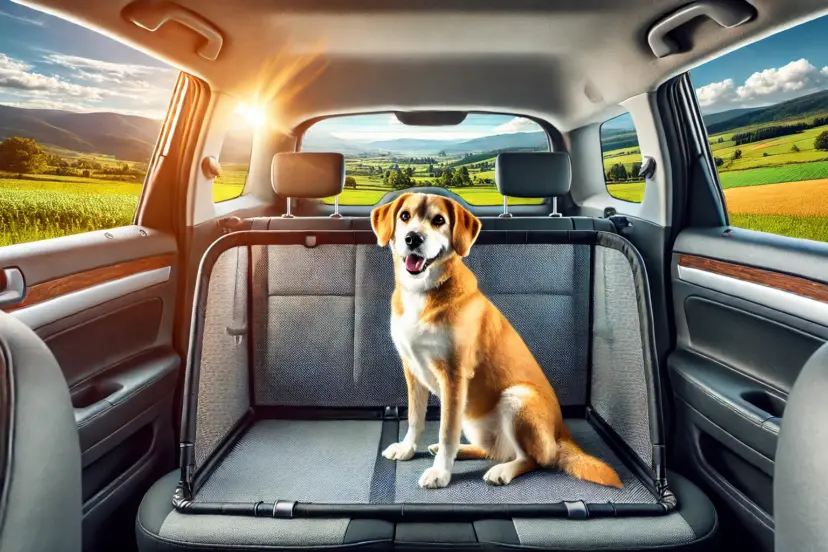Pet Barrier for Car: Comfortable Adventures with Your Pet
We may earn a commission for purchases made using our links. Please see our disclosure for more details.
Why You Need a Pet Barrier for Your Car
Has your dog ever curled up on your lap like a moving dog bed or jumped into the front seat while you were driving? Cute? Indeed. Secure? Not in that way. Your pet can stay in the back with a pet barrier, protecting everyone’s safety. It frees you from worrying about unforeseen dog antics so you can concentrate on the road. A pet barrier makes traveling more peaceful for both of you, whether it’s for a short trip to the vet or a road trip to a new adventure.
What Exactly is a Pet Barrier?
A pet barrier is like a seatbelt for your dog—except it keeps them in the back where they belong. It’s a divider that separates the front and rear seats, or the trunk area, to prevent pets from roaming the car. No more surprise visits from your dog in the passenger seat while you’re navigating traffic. It keeps them safe and contained, making driving safer for everyone involved.
Types of Pet Barriers for Cars
Different cars and pets need different solutions. Mesh barriers are lightweight and ideal for smaller pets or occasional trips. Metal barriers, on the other hand, provide heavy-duty security, perfect for larger dogs. If you need versatility, adjustable barriers fit various car models. Cargo barriers keep pets in the trunk of SUVs, while seat barriers block off the front seats, ensuring your pet stays where they should.
Choosing the Right Barrier for Your Pet and Vehicle
The right barrier depends on both your pet and your car. A large, energetic dog might require a sturdier option, while a smaller dog could be comfortable with a lightweight mesh barrier. Think about how often you travel too. If your pet joins you daily, a more durable, permanent barrier makes sense. For occasional trips, a portable barrier is probably the better choice.
Why Invest in a Pet Barrier?
A pet barrier is not just a convenience—it’s essential for safety. It keeps pets from jumping into the front seat and distracting the driver. Many pets also feel more comfortable when they have a defined space, reducing travel anxiety. A barrier can protect your car’s interior from scratches and chewed seatbelts, and with pets staying in their spot, both of you can enjoy a smoother ride.
Installing a Pet Barrier: Easier Than You Think
Installing a pet barrier doesn’t require special skills or tools. Simply find the right spot—between the seats or in the trunk—and adjust it to fit snugly. Most barriers come with hooks or straps that make securing them easy. Once installed, give it a little push to make sure it stays in place.
Feeling Crafty? Try a DIY Barrier
If you enjoy DIY projects, you can make a simple barrier with mesh panels or PVC pipes. While a homemade solution might be cheaper, it’s essential to ensure it’s strong enough to hold up in an emergency. If your dog is an escape artist, a DIY barrier might not cut it when they’re determined to join you in the front seat.
Keeping Your Pet Comfortable on the Road
The barrier is up, but keeping your pet content back there is just as important. Familiar toys or blankets can help make the space feel like home. Take regular breaks during long drives to let your pet stretch and hydrate. Using seat covers or hammocks adds extra padding, and it’s always a good idea to start with short trips so your pet gets used to the barrier.
Safety Concerns with Pets in Vehicles
Research from the Center for Pet Safety (CPS) shows that 100% of tested dog restraints failed, which means pets and passengers are at risk during crashes. Unrestrained pets can become projectiles, causing harm to passengers, and some harnesses can even injure pets by tightening on impact. The study also revealed that drivers with pets in the car have a 1.89 times higher chance of getting into a collision. Keeping pets secured with a barrier or harness is essential to minimize these risks.
Common Mistakes When Using Pet Barriers
One of the biggest mistakes people make is choosing the wrong size barrier. A flimsy barrier might work for a small dog, but it won’t stop a larger one from pushing through. Installation errors are another common issue—double-check those straps and clamps. Skipping the training process can also create problems, as pets need time to get comfortable with the barrier. And don’t forget to inspect it regularly for any signs of wear and tear.
Training Your Pet to Use the Barrier
Getting your pet used to a barrier isn’t always easy, especially if they love being close to you during car rides. Start with short trips, rewarding them with treats and praise. If your pet seems nervous, sit in the back seat with them a few times to reassure them. Patience is key—soon enough, your pet will see the barrier as just another part of the ride.
Not Just for Dogs: Barriers Work for Other Pets Too
While dogs are the most common passengers, pet barriers can also be used for other animals. Cats, rabbits, and even adventurous birds can benefit from having a secure space during car rides. Just make sure the barrier matches their size and behavior.
Barrier vs. Crate: Which is Right for Your Pet?
A barrier offers freedom to move within a defined space, which works well for pets comfortable with travel. However, anxious pets might do better in a crate where they feel more secure. A crate takes up more space but can be a lifesaver for pets who prefer confined areas. The choice depends on your pet’s personality and how they behave in the car.
Related Products to Pair with Your Pet Barrier
To make your pet’s travel experience even better, consider adding these products:
- Seat Covers for Pets – Protect your seats from fur, dirt, and scratches.
- Pet Car Harnesses – Offer extra safety by securing your pet to the seatbelt.
- Car Hammocks – Create a cozy space and protect your seats.
- Travel Water Bowls – Keep your pet hydrated during long trips.
- Pet Ramps for Cars – Help older or smaller pets get in and out with ease.
- Cooling Pads or Blankets – Keep your pet comfortable, especially in warm weather.
- Pet Cameras – Monitor your pet during drives for extra peace of mind.
Maintaining and Cleaning Your Pet Barrier
A little maintenance goes a long way in keeping the barrier functional and fresh. Wipe down metal or plastic barriers with a damp cloth, and vacuum mesh barriers to remove fur. Regularly inspect the fittings to ensure the barrier stays secure and doesn’t loosen over time.
Summary: Pet Barriers Make Every Journey Safer
A pet barrier isn’t just an accessory—it’s essential for safe, smooth, and comfortable travel with your pet. It keeps distractions at bay, protects your pet, and ensures everyone enjoys the ride. From lightweight mesh barriers to sturdy metal options, there’s something for every pet and vehicle. Pair it with the right accessories, and you’ll be ready for any adventure, big or small.
5 FAQs About Pet Barriers for Cars
- Do pet barriers fit all car models?
Most barriers are adjustable, but it’s a good idea to check product details for compatibility. - Are pet barriers easy to install?
Yes! Most barriers are designed for easy installation without any tools. - Can I use a pet barrier for cats?
Absolutely, though some cats might prefer being in a carrier. - Can I use one barrier for multiple pets?
Yes, just make sure the barrier is strong and spacious enough for all of them. - How often should I inspect the barrier?
Check it regularly, especially after long trips, to make sure everything is secure.
With the right pet barrier, you and your furry friend can enjoy every journey without a hitch. Safe travels! 🚗🐾




